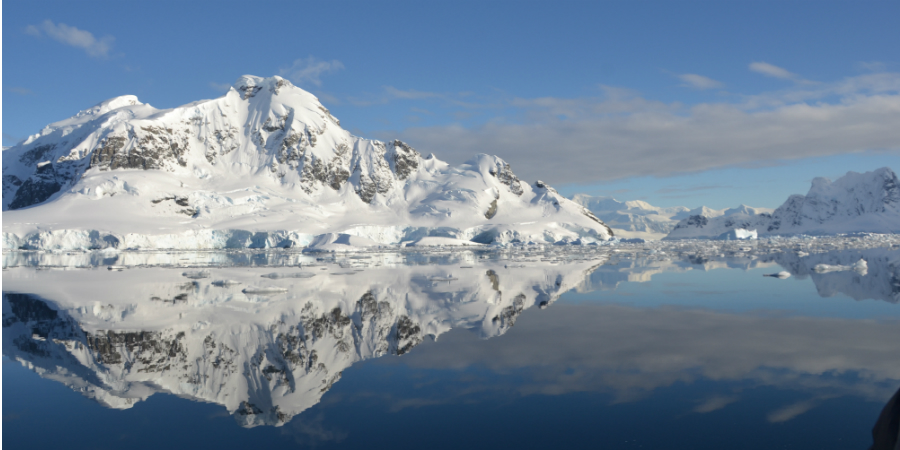China’s Advance Into the Antarctic
Editor’s Note: Major powers have never fought over Antarctica, and indeed its peaceful status is a diplomatic success that has lasted decades. David Fishman, a former Brookings intern, argues that this may be changing, a development driven in part by climate change. China, in particular, is becoming more assertive in the Antarctic, and Fishman contends that the United States needs to recognize this new reality and adapt accordingly.
Daniel Byman
***

Published by The Lawfare Institute
in Cooperation With

Editor’s Note: Major powers have never fought over Antarctica, and indeed its peaceful status is a diplomatic success that has lasted decades. David Fishman, a former Brookings intern, argues that this may be changing, a development driven in part by climate change. China, in particular, is becoming more assertive in the Antarctic, and Fishman contends that the United States needs to recognize this new reality and adapt accordingly.
Daniel Byman
***
The Arctic, a sprawling 5.5-million-square-mile region sandwiched between the United States and Russia, has become a site of geopolitical tension as rising temperatures thaw massive ice chunks that previously impeded navigation. But while the world watches the North Pole, an equally large hunk of ice at the bottom of the globe is also rapidly becoming an arena for great power competition.
Antarctica, the world’s “last great wilderness,” has for six decades been largely shielded from exploitation. A 1959 agreement born out of Cold War necessity and eventually joined by 54 countries reserved the continent “exclusively for peaceful purposes.” What began as a single agreement expanded into a web of interlocking rules and regulations known as the Antarctic Treaty System (ATS). The ATS applies to land and sea, existing alongside other international laws—like the 1982 U.N. Convention on the Law of the Sea—to prevent conflict, foster international cooperation and enable scientific development.
But things are changing. A provision of the ATS permits signatories to renegotiate in 2048, opening up the potential for resource exploitation. Experts believe Antarctica has a trove of resources, including oil, minerals, commercial fishing, and coal and hydrocarbons. In addition, the region houses the largest freshwater reserve on Earth in large ice sheets, which could soon become attractive to drought-stricken areas. While 2048 may seem distant—and major technological hurdles preclude immediate progress—some global powers have already begun a slow march onto the continent. In contrast, the United States’s preparations have lagged. One U.S. Air Force general recently urged for more polar investment and warned that competition in Antarctica “is just a number of years” away.
Among ATS signatories, China has the fastest growing presence, with four Antarctic bases and a fifth underway. Beijing has also in recent years ramped up research expenditures, signed a fueling partnership with Australia, constructed a new icebreaker, announced a permanent airfield and grown its polar tourism industry exponentially. In addition, some evidence suggests China may have already breached parts of the treaty through unreported military and development activities—mirroring a similar disregard for international law in the South China Sea. Whether Beijing has a formal long-term “Antarctic strategy” is unclear, but focus on the seventh continent fits into broader Chinese foreign policy aimed at commercial dominance (shipping lanes, fisheries, future resource exploitation), food and fuel security (potential oil and gas reserves, fresh water, biological resources), and combating Western influence. Beijing sees the region as a “‘treasure house of resources’” critical for its continued economic growth, according to leading Antarctic scholar Anne-Marie Brady.
Several recent developments make Antarctica an urgent geostrategic concern. First, rapidly worsening climate change—scientists in 2015 noted a record-high temperature of 63.5°F—has led to a reduction in the continent’s ice mass. As a result, it is becoming increasingly feasible to reach resources beneath the cold surface. Second, pressure from an increasingly heterogeneous group of signatories to further open up governance—resulting in part from regulatory gaps in the current ATS infrastructure—will likely threaten the ATS’s integrity. And third, unresolved sovereignty questions may enable increasingly aggressive behavior by major powers such as China.
The United States should think carefully about these upcoming flashpoints in Antarctic climate, governance and sovereignty. China’s demonstrated Arctic strategy can serve as a road map for policymakers to extrapolate its potential Antarctic agenda. The latter may be a generation behind the former, but Alan D. Hemmings—who has identified a set of “pressure points” for international competition in Antarctica—notes, “[T]his is coming to Antarctica too.” As one Chinese scientist recently told the South China Morning Post, “It is a battle of political will, military power, global influence … and it has been heating up.”
First, as climate change makes resource extraction more feasible and exacerbates limitations on domestic consumption, China will likely seek to rhetorically integrate Antarctica into its Belt and Road Initiative (BRI) and pursue environmental policies that increase territorial influence. Exploitation of Antarctic resources will probably become inevitable as domestic needs grow, turmoil in the Middle East continues and geopolitical competition drives incentives for diversification. Antarctic integration into the BRI will allow Beijing to advance its geopolitical aspirations through a well-established strategy: working via bilateral relationships with local stakeholders such as Australia and Chile, framing its actions with a narrative connection to the “ancient Silk Road,” and emphasizing its benign intentions. In the Arctic, for example, China has created a so-called “Arctic Silk Road” that links the region symbolically to a larger historical narrative. In addition to the BRI, Beijing will likely support or block environmental initiatives to gain tactical advantage and regional influence. For example, China in 2017 backed an international moratorium on Arctic fishing, proclaiming support for “conservation in a scientific manner.” Timo Koivurova argues that Beijing, as a mere “observer,” had to invoke “the entire framework of international law” to gain control. China is not bound by the same limitation in Antarctica as a consultative party and has therefore pursued a different strategy. Over the past several years, the country has pushed to designate the continent’s highest point an Antarctic Specially Managed Area, which would allow China to lead “the planning and coordination of activities.” In short, Brady notes, Beijing views environmental regulation in the polar regions as a “gambit to control territory.”
Second, growing pressure from signatories to open up governance and accommodate new geopolitical developments may threaten ATS integrity—creating space for China to increase influence through bilateral relationships and craft its identity as a powerful Antarctic player. China will almost certainly seek to increase influence in the ATS on a bilateral basis with key players. In the Arctic, Beijing has targeted states with territorial claims to gain influence and control over a burgeoning commercial field. For example, the country seeks to invest in key ports around Russia, Greenland, Iceland and Norway. China will likely pair financial support with efforts to grow its identity as a powerful (and responsible) regional influencer, which would ensure inclusion in future Antarctic deliberations. In the Arctic, Beijing has proclaimed itself a “near-Arctic state” and in 2013 gained observer status on the Arctic Council, allowing it to help formulate policy. China has also used actors at home (scientific institutions, tourist agencies, media, cultural initiatives and bloggers) to bolster its polar connection. Brady notes that Beijing has already begun crafting a narrative around Antarctica based on five key frames: past exclusion from science and governance, a treasure chest of mineral resources, a global commons, a barometer of climate change, and “a zone for China’s emergence as a global power.”
Third, unresolved Antarctic sovereignty questions will likely allow China to expand its domestic presence on the continent and lay the groundwork for territorial claims. While seven nations claim territory in Antarctica, none has been legally recognized. Instead, as Elizabeth Nyman argues, the ATS freezes existing claims in a “‘purgatory of ambiguity’” that poses “the biggest threat to Antarctic security.” China is poised to mobilize public-sector assets and its formidable private sector to capitalize on the ambiguous situation. Beijing privately views Antarctic sovereignty and resources as “first come, first served,” Brady notes. China will likely use informal mechanisms to gain a foothold on the continent. For example, the country has increased place naming, permanent bases and research funding. Beijing will likely also continue to increase domestic presence in and awareness of the region, laying the groundwork for possible territorial claims. Chinese tourism in Antarctica has grown 100-fold since 2008; and the government has shaped public sentiment with domestic films, newspaper articles and even high school exam questions. Finally, China will almost certainly pair its growing presence on the continent with bilateral diplomacy and commercial relationships aimed at territorial claimants. In 2014, for example, China signed a five-year agreement with Australia—a country that claims 42 percent of Antarctica—to provide its vessels and aircraft with fuel. The accord will “help secure easier access to (the) region.” More recently, China opened negotiations with Chile over the use of a critical port to facilitate its polar projects.
For the United States to compete in this frozen arena, it needs an Antarctic game plan. First, officials should allocate more resources to polar capabilities. The United States stands woefully unprepared to compete in Antarctica with just three (aging) stations, a single failing icebreaker, a lack of capital investment and dated communication technology. A 2012 National Science Foundation report noted that the U.S. Antarctic Program “badly” needs remediation and “will cost more to restore as each year of inattention passes.” Second, the United States should emphasize Antarctic cooperation with allies such as Australia (particularly in light of Canberra’s recent “China reset”), which have more experience and influence in the region. No recent joint statements from the Australia-United States Ministerial Consultations—the two nations’ principal bilateral forum—have explicitly mentioned Antarctica. The United States should also consider prioritizing the issue at other key forums like “The Quad” and the Organization of American States, which include numerous ATS signatories. Without a renewed focus on polar collaboration, Washington risks losing out to an increasingly assertive Beijing. Third, the United States should work with other ATS signatories to ensure treaty compliance and maintain the status quo. The ATS does not have a clear mechanism by which parties can punish violators. Instead, the United States and its allies should publicly broadcast infractions and pursue sanctions through other international forums like the United Nations.





